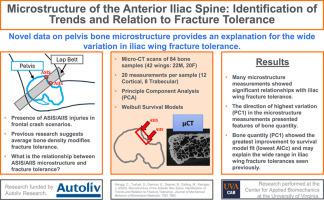Microstructure of the anterior iliac Spine: Identification of trends and relation to fracture tolerance
IF 3.5
2区 医学
Q2 ENGINEERING, BIOMEDICAL
Journal of the Mechanical Behavior of Biomedical Materials
Pub Date : 2025-09-01
DOI:10.1016/j.jmbbm.2025.107174
引用次数: 0
Abstract
Seatbelt-induced pelvic iliac wing injuries have been observed since the 1970s, but only recently has there been quantification of fracture tolerance and injury risk of the iliac wing. Previous studies have shown a wide variation in iliac wing fracture tolerance with no significant relationships to pelvis size, sex, or other factors. A weighted average bone density (BD) calculation of the entire iliac wing produced the best predictive performance of fracture tolerance in parametric (Weibull) survival models. As a result, we endeavored to evaluate local bone microstructural properties at the site of loading and evaluate their relationship to fracture tolerance. Anterior iliac spine samples (ASIS, AIIS) were extracted from 42 iliac wings, originating from 11 male and 10 female post-mortem human surrogates (PMHS). Samples were scanned using micro-computed tomography, then 20 different cortical and trabecular bone measurements for each sample were evaluated. A principal component analysis (PCA) was conducted to reduce the dimensionality and identify the features of iliac wing microstructure that account for the most variation in the measurements. The first principal component, which represented bone quantity, accounted for over 33 % of the variation in the specimen microstructures. This component improved the survival model fit to the data more than any other previous model. Results suggest that bone quantity may explain much of the variation in iliac wing fracture tolerance.

髂前棘的微观结构:趋势的识别和与骨折耐受性的关系
自20世纪70年代以来,安全带引起的骨盆髂翼损伤已被观察到,但直到最近才对髂翼的骨折耐受性和损伤风险进行量化。先前的研究表明,髂翼骨折耐受性的差异很大,与骨盆大小、性别或其他因素没有显著关系。在参数(Weibull)生存模型中,整个髂翼的加权平均骨密度(BD)计算产生了最佳的骨折耐受性预测性能。因此,我们努力评估加载部位的局部骨微结构特性,并评估它们与骨折耐受性的关系。髂前棘样本(ASIS, AIIS)取自11名男性和10名女性死后代孕人(PMHS)的42个髂翼。使用微型计算机断层扫描样品,然后对每个样品的20种不同的皮质和小梁骨测量值进行评估。主成分分析(PCA)进行了降维和识别特征的髂翼微结构,占最大的变化在测量。第一个主成分,代表骨量,占标本显微结构变化的33%以上。该组件比以往任何其他模型都更能改善生存模型对数据的拟合。结果表明,骨量可能解释了髂翼骨折耐受性的变化。
本文章由计算机程序翻译,如有差异,请以英文原文为准。
求助全文
约1分钟内获得全文
求助全文
来源期刊

Journal of the Mechanical Behavior of Biomedical Materials
工程技术-材料科学:生物材料
CiteScore
7.20
自引率
7.70%
发文量
505
审稿时长
46 days
期刊介绍:
The Journal of the Mechanical Behavior of Biomedical Materials is concerned with the mechanical deformation, damage and failure under applied forces, of biological material (at the tissue, cellular and molecular levels) and of biomaterials, i.e. those materials which are designed to mimic or replace biological materials.
The primary focus of the journal is the synthesis of materials science, biology, and medical and dental science. Reports of fundamental scientific investigations are welcome, as are articles concerned with the practical application of materials in medical devices. Both experimental and theoretical work is of interest; theoretical papers will normally include comparison of predictions with experimental data, though we recognize that this may not always be appropriate. The journal also publishes technical notes concerned with emerging experimental or theoretical techniques, letters to the editor and, by invitation, review articles and papers describing existing techniques for the benefit of an interdisciplinary readership.
 求助内容:
求助内容: 应助结果提醒方式:
应助结果提醒方式:


